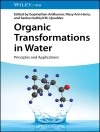Science of Synthesis: Houben-Weyl Methods of Molecular Transformations is the entirely new edition of the acclaimed reference series Houben-Weyl, the standard synthetic chemistry resource since 1909. This new edition is published in English and will comprise 48 volumes published between the years 2000 and 2008.
Science of Synthesis is a quality reference work developed by a highly esteemed editorial board to provide a comprehensive and critical selection of reliable organic and organometallic synthetic methods. This unique resource is designed to be the first point of reference when searching for a synthesis strategy.
- Contains the expertise of presently 400 leading chemists worldwide
- Critically evaluates the preparative applicability and significance of the synthetic methods
- Discusses relevant background information and provides detailed experimental procedures
For full information on the Science of Synthesis series, visit the Science of Synthesis Homepage
Inhaltsverzeichnis
<p>5.1 Product Class 1: Germanium Compounds<br>5.1.1 Product Subclass 1: Germanium Hydrides<br>5.1.2 Product Subclass 2: Digermenes and Digermanes<br>5.1.3 Product Subclass 3: Metalated Germanium Compounds<br>5.1.4 Product Subclass 4: Germanium Oxides, Sulfides, Selenides, and Tellurides (Double Bonded)<br>5.1.5 Product Subclass 5: Iminogermanes<br>5.1.6 Product Subclass 6: Germenes<br>5.1.7 Product Subclass 7: Germylenes<br>5.1.8 Product Subclass 8: Organogermanium Halides<br>5.1.9 Product Subclass 9: Germanium Oxides<br>5.1.10 Product Subclass 10: Germanium Carboxylates, Phosphates, and Related Compounds<br>5.1.11 Product Subclass 11: Germanium Sulfides, Sulfoxides, and Related Compounds<br>5.1.12 Product Subclass 12: Germanium Selenides, Tellurides, and Related Compounds<br>5.1.13 Product Subclass 13: Germylamines<br>5.1.14 Product Subclass 14: Germanium Phosphines, Arsines, and Stibines<br>5.1.15 Product Subclass 15: Germanium Cyanides<br>5.1.16 Product Subclass 16: Acylgermanes<br>5.1.17 Product Subclass 17: Imidoylgermanes (α-Iminoalkylgermanes) and α-Diazoalkylgermanes<br>5.1.18 Product Subclass 18: α-Halo- and α-Alkoxyvinylgermanes<br>5.1.19 Product Subclass 19: α-Halo-, α-Hydroxy-, α-Alkoxy-, and α-Aminoalkylgermanes<br>5.1.20 Product Subclass 20: Alkynylgermanes<br>5.1.21 Product Subclass 21: Germylketenes and Germylketenimines<br>5.1.22 Product Subclass 22: Aryl- and Heteroarylgermanes<br>5.1.23 Product Subclass 23: Vinylgermanes<br>5.1.24 Product Subclass 24: Propargyl- and Allenylgermanes<br>5.1.25 Product Subclass 25: Benzylgermanes<br>5.1.26 Product Subclass 26: Allylgermanes<br>5.1.27 Product Subclass 27: Alkylgermanes<br>5.2 Product Class 2: Tin Compounds<br>5.2.1 Product Subclass 1: Tin Hydrides<br>5.2.2 Product Subclass 2: Distannenes and Distannanes<br>5.2.3 Product Subclass 3: Metalated Tin Compounds<br>5.2.4 Product Subclass 4: Tin Oxides, Sulfides, Selenides, and Tellurides (Double Bonded)<br>5.2.5 Product Subclass 5: Iminostannanes<br>5.2.6 Product Subclass 6: Stannenes<br>5.2.7 Product Subclass 7: Stannylenes<br>5.2.8 Product Subclass 8: Tin Halides and Organotin Halides<br>5.2.9 Product Subclass 9: Tin Oxides<br>5.2.10 Product Subclass 10: Tin Carboxylates and Phosphates<br>5.2.11 Product Subclass 11: Tin Enol Ethers<br>5.2.12 Product Subclass 12: Tin Sulfides, Thioalkoxides, and Related Compounds<br>5.2.13 Product Subclass 13: Tin Selenides and Tellurides<br>5.2.14 Product Subclass 14: Organostannylamines and Related Compounds<br>5.2.15 Product Subclass 15: Organostannylphosphines<br>5.2.16 Product Subclass 16: Tin Cyanides and Fulminates<br>5.2.17 Product Subclass 17: Acylstannanes (Including S, Se, and Te Analogues)<br>5.2.18 Product Subclass 18: Imidoylstannanes, Diazoalkylstannanes, Tin Isocyanates, and Tin Isothiocyanates<br>5.2.19 Product Subclass 19: 1-Halo-, 1-Alkoxy-, and 1-Aminovinylstannanes<br>5.2.20 Product Subclass 20: 1-Halo-, 1-Hydroxy-, 1-Alkoxy-, and 1-Aminoalkylstannanes<br>5.2.21 Product Subclass 21: Alkynylstannanes<br>5.2.22 Product Subclass 22: Ketenylstannanes and Derivatives<br>5.2.23 Product Subclass 23: Allenylstannanes<br>5.2.24 Product Subclass 24: Arylstannanes<br>5.2.25 Product Subclass 25: Alk-1-enylstannanes<br>5.2.26 Product Subclass 26: Propargylstannanes<br>5.2.27 Product Subclass 27: Benzylstannanes<br>5.2.28 Product Subclass 28: Allylstannanes<br>5.2.29 Product Subclass 29: Alkylstannanes<br>5.3 Product Class 3: Lead Compounds<br>5.3.1 Product Subclass 1: Lead Hydrides<br>5.3.2 Product Subclass 2: Diplumbenes and Diplumbanes<br>5.3.3 Product Subclass 3: Metalated Lead Compounds<br>5.3.4 Product Subclass 4: Organoplumbyl Oxides, Sulfides, Selenides, and Tellurides (Double Bonded)<br>5.3.5 Product Subclass 5: Plumbylenes<br>5.3.6 Product Subclass 6: Halo(organo)plumbanes<br>5.3.7 Product Subclass 7: Organoplumboxanes and Related Compounds<br>5.3.8 Product Subclass 8: Acyloxy(organo)plumbanes<br>5.3.9 Product Subclass 9: Plumbyl Enol Ethers<br>5.3.10 Product Subclass 10: Organoplumbane Sulfur Compounds<br>5.3.11 Product Subclass 11: Organoplumbyl Selenides, Tellurides, and Related Compounds<br>5.3.12 Product Subclass 12: Organoplumbanamines and Related Compounds<br>5.3.13 Product Subclass 13: Organoplumbyl Phosphines and Phosphine Oxides<br>5.3.14 Product Subclass 14: Triorganolead Cyanides and Triorganolead Cyanates<br>5.3.15 Product Subclass 15: Acylplumbanes<br>5.3.16 Product Subclass 16: Lead Isocyanates, Isothiocyanates, Diazoplumbanes, and Iminoplumbanes<br>5.3.17 Product Subclass 17: 1- or 2-Alkoxy- and 1- or 2-(Alkylsulfanyl) and 1- or 2-Aminoalkenyl(triorgano)plumbanes<br>5.3.18 Product Subclass 18: 1-Halo-, 1-Alkoxy-, 1-Hydroxy-, and 1-Aminoalkylplumbanes<br>5.3.19 Product Subclass 19: Alkynylplumbanes<br>5.3.20 Product Subclass 20: Allenylplumbanes<br>5.3.21 Product Subclass 21: Arylplumbanes<br>5.3.22 Product Subclass 22: Vinylplumbanes<br>5.3.23 Product Subclass 23: Benzylplumbanes<br>5.3.24 Product Subclass 24: Allylplumbanes<br>5.3.25 Product Subclass 25: Alkylplumbanes</p>
Über den Autor
Mark G. Moloney












